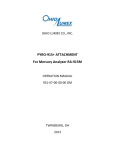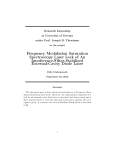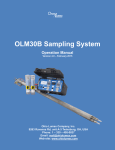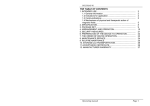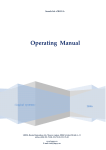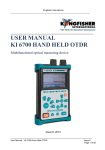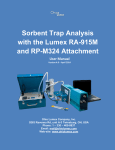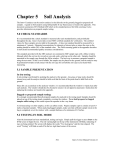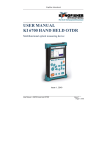Download OL Light 915 OM 20121010 Manual
Transcript
OHIO LUMEX CO., INC. LIGHT-915 MERCURY ANALYZER OPERATION MANUAL 01101-00-00-00-00 OM TWINSBURG, OH 2012 Read the instructions in this manual carefully before operating the Light-915 analyzer. Neither OHIO LUMEX CO., INC. nor its representatives will accept any liability for damage caused by non-observance of the requirements of this manual. Light-915 MERCURY ANALYZER is subject to improvements and the information in this manual may not include the latest updates on the Light-915 MERCURY ANALYZER design. No part of this manual may be reproduced or transmitted in any form or by any means, neither electronically nor mechanically, without the prior written permission of OHIO LUMEX CO., INC. Contacts: 9263 Ravenna Rd. Unit A-3 Twinsburg, Ohio 44087 Toll Free (888) 876 2611, (330) 405 0837, Fax. (330) 405 0847 Correspondence: Email: [email protected] Web: www.ohiolumex.com Operation manual Light-915 01101-00-00-00-00 OM I About this manual This manual is designed to familiarize you with the principle of operation and structure of the Light-915 analyzer (hereinafter referred to as the «analyzer»), its design, performance characteristics and operating conditions. It contains information that will provide proper operation and comprehensive utilization of the analyzer’s capabilities. Please take time to read the manual in order to attain the best results in operation and to gain the greatest benefit from your analyzer. This manual contains: • List of important safety measures, warnings and precautions, which you should follow when operating with the analyzer; • The intended purpose of the analyzer, its basic performance, analytical characteristics, and operating conditions; • Brief description of the physical foundations and the principle of operation of the analyzer, and of its design; • Functional controls of the analyzer, their purpose and operation; • Procedures for preparation of the analyzer for operation in different configurations using appropriate operation modes; • Procedures for handling the analyzer in all of the operation modes using the display and control unit; • Brief description of procedures for analyzer operation using a PC; • Procedures for analyzer maintenance; • Instructions for troubleshooting. II Operation manual Light-915 01101-00-00-00-00 OM Symbols used in this manual Danger: Used when failure to observe a safety precaution may result in a serious injury. Warning: Used when there is a danger of a minor injury or a serious damage to the analyzer if you do no follow the precautions. Caution: Used when there is a danger of a minor damage to the analyzer if you do no follow the precautions. Used to indicate supplementary information or to call attention to recommendations which may simplify daily operation. Safety guidelines Important safety precautions Read these rules completely before starting operation with analyzer. • Carefully study all the sections of this operation manual, analyzer design and control functions; • To avoid electrical shock, never work with the analyzer covers removed; • Do not put extraneous objects inside the analyzer through its ports; • Do not spill any kind of liquid on the case and do not allow the ingress of liquids or inside the analyzer; • Use only the power supply which is provided; • Never use a defective power supply cable, do not put any objects on the power supply cable, and locate it in a manner to avoid a trip hazard; Operation manual Light-915 01101-00-00-00-00 OM III • Do not try to repair the analyzer or adjust its optical units and electronic boards by yourself, except for cases stipulated in troubleshooting section (Annex A); • Call an authorized agent or certified service engineer in the following cases: If the analyzer does not operate properly or its parameters have noticeably deteriorated; If the analyzer has fallen down or if its case is damaged; If there has been ingress of any liquid inside the analyzer; If you hear unusual sounds or sense unusual smell coming from the analyzer. • Keep the analyzer at a minimum distance of 1 meter from heating devices and heat sources. Do not transport the analyzer in the boot of your car; • Do not forget to switch the analyzer off when the working day is over and to disconnect the power supply unit from the mains if the analyzer is not used for more than 6 hours; • Never work without sorption and dust filters; • The analyzer should be switched off before any maintenance operations; • When measuring mercury concentration, it is necessary to follow instructions and documents stating safety regulations for operation in chemical laboratories and safety rules for operation with electric appliances; Observe the following rules during any transportation of the instrument, as well as when performing measurements from a moving vehicle (car, helicopter, etc.): • To avoid strong vibration effects, do not place the instrument on a hard surface (baggage compartment, floor of a vehicle, etc.); • Place the instrument on shock-insulated surfaces (a seat, damping support, etc.); IV Operation manual Light-915 01101-00-00-00-00 OM • Secure the instrument on a working surface to prevent its fall or incidental contact with other objects; Observe the following safety precautions during outdoor operation: • Do not work in rainy or foggy weather and avoid precipitation ingress inside the analyzer; • Do not work in dusty environment; • Personnel members permitted to operate the instrument are recommended to undergo training at the supplier’s premises or at a regional service centre; Contents I Contents 1 1.1 1.2 1.3 1.4 Introduction.............................................................................................. 1 General description ................................................................................ 1 Performance characteristics and specifications ..................................... 2 Operating conditions .............................................................................. 3 Analyzer design...................................................................................... 3 1.4.1 General Principles of Operation ...................................................................3 1.4.2 Description of Analyzer ................................................................................5 1.4.3 Display and Control Unit ..............................................................................7 2 2.1 Analyzer operation .................................................................................. 8 Pre-operational Procedures and Setup .................................................. 8 2.1.1 2.1.2 2.1.3 2.1.4 2.1.5 2.1.6 2.1.7 2.2 Unpacking and Installation ...........................................................................8 Analyzer installation and starting up.............................................................9 Charging the Battery ..................................................................................10 Setting Parameters ....................................................................................11 Checking Analyzer Serviceability ...............................................................15 Probe with dust filter and hose ...................................................................17 Using PDA computer..................................................................................17 Analyzer Operation .............................................................................. 18 2.2.1 Operation in the On Stream Mode..............................................................18 2.2.2 Operation in the Monitoring Mode ..............................................................20 2.3 Controlling the analyzer by PDA computer........................................... 23 2.3.1 2.3.2 2.3.3 2.3.4 2.4 Connecting the analyzer to PDA computer.................................................23 Checking serviceability of the analyzer ......................................................24 Monitoring mode settings ...........................................................................26 Measuring in the Monitoring mode .............................................................27 Application examples of the analyzer ................................................... 28 2.4.1 Measuring mercury vapour concentration in the air at discrete locations....28 2.4.2 Searching local sources of mercury contamination ....................................30 2.4.3 Monitoring of the mercury vapour concentration.........................................33 2.5 Analyzer Maintenance.......................................................................... 34 2.5.1 2.5.2 2.5.3 2.5.4 3 Replacement of the mercury lamp..............................................................34 Replacement of the built-in battery.............................................................38 Replacement of the built-in sorption (zero) filter .........................................39 Replacement of the dust filter.....................................................................41 Troubleshooting .................................................................................... 43 II Operation manual Light-915 01101-00-00-00-00 OM 4 Analyzer Storage and Transportation.................................................. 45 5 Warranty................................................................................................. 46 Annex A (informative) Physical Foundation and Principle of Operation . 47 List of Figures I List of Figures Fig. 1-1 – The Light-915 Analyzer .................................................................................... 5 Fig. 1-2 – Front panel of the analyzer............................................................................... 6 Fig. 1-3 – Rear panel of the analyzer ............................................................................... 6 Fig. 1-4 – Display and control unit .................................................................................... 7 Fig. 2-1 – Splash screen .................................................................................................. 9 Fig. 2-2 – Main menu window......................................................................................... 10 Fig. 2-3 – Settings menu window ................................................................................... 12 Fig. 2-4 – Parameters Menu........................................................................................... 14 Fig. 2-5 – Save parameters dialog ................................................................................. 15 Fig. 2-6 – Test mode window ......................................................................................... 16 Fig. 2-7 – On Stream mode window ............................................................................... 19 Fig. 2-8 – Initial screen of the Monitoring mode.............................................................. 21 Fig. 2-9 – Monitoring mode display ................................................................................ 22 Fig. 2-10 – Selecting connection mode .......................................................................... 23 Fig. 2-11 – Initial window of the RA915mon application. The analyzer is connected ..... 24 Fig. 2-12 – Test window ................................................................................................. 24 Fig. 2-13 – Test window during the test procedure......................................................... 25 Fig. 2-14 – Test window after the successful test procedure.......................................... 25 Fig. 2-15 – Monitoring mode window before starting the measurement ......................... 26 Fig. 2-16 – Monitoring Settings window.......................................................................... 26 Fig. 2-17 – Monitoring mode window during the measurement ...................................... 27 Fig. 2-18 – Location of the built-in battery and the mercury lamp................................... 35 Fig. 2-19 – Removing the front panel of the analyser..................................................... 35 Fig. 2-20 – Removing the protective cap........................................................................ 36 Fig. 2-21 – Disconnecting the snatch plug of the light source ........................................ 36 Fig. 2-22 – Removing the mercury lamp ........................................................................ 36 Fig. 2-23 – Power wires placing ..................................................................................... 37 Fig. 2-24 – Wires placing................................................................................................ 37 Fig. 2-25 – Disconnecting the snatch plug of the built-in battery .................................... 38 Fig. 2-26 – Removing the built-in battery........................................................................ 38 II Operation manual Light-915 01101-00-00-00-00 OM Fig. 2-27 – Location of dust and sorption filters of the analyzer ..................................... 39 Fig. 2-28 – Removing the right-hand side cover............................................................. 40 Fig. 2-29 – Removing the sorption filter cap................................................................... 40 Fig. 2-30 – Closing the sorption filter cap ....................................................................... 41 Fig. 2-31 – Removing the dust filter cap......................................................................... 42 Fig. 2-32 – Removing the dust filter ............................................................................... 42 Fig. A- 1 – Principle of operation of the Light-915 mercury analyzer.............................. 47 Fig. A-2 – Block diagram of the Light-915 mercury analyzer.......................................... 48 01101-00-00-00-00 OM 1 Section 1 Introduction 1 Introduction 1.1 General description The Light-915 Analyzer is intended for measuring mercury vapour concentration in the ambient air and in the air of residential quarters and production areas. The analyzer can be used for on-stream measuring of mercury vapour concentration in the air both in a stationary mode and for continuous survey from vehicles (car, helicopter, boat). The analyzer is a useful tool in industrial hygiene, ecological monitoring, technological process control and scientific research. Read this manual carefully before starting operation with the analyzer. 2 Operation manual Light-915 01101-00-00-00-00 OM 1.2 Performance characteristics and specifications Measuring range of the mercury vapour mass concentration in air (accumulation time 30 s), µg/m3 Relative intrinsic error of measurement (δ0), not more than, % 0.1 …3000 ± 20 Minimum duration of the measurement procedure in On Stream mode, s 30 Measurement repeatability (span) for the mercury vapour mass concentration of 1µg/m3 and higher, %, not more than 5 Standard deviation of the zero signal within one measurement procedure in On Stream mode (30 s), not more than, µg/m3 0.025 Drift of zero signal within one measurement procedure in On Stream mode (30 s), not more than, µg/m3 0.025 Transitory time of analyzer readings, s, not more than 10 Analyzer warm-up time, min, not more than 20 Volume air flow rate of the analyzed air at the analyzer input, dm3/min, not less than 5 Sorption coefficient of mercury vapour by the built-in sorption filter, not less than, % 98 Complementary error caused by the ambient temperature change within the operating range for each 10°С, not more than, % ±0.5δ0 Complementary error caused by the ambient pressure change within the operating range for each 3.3 kPa is not more than, % ±0.2δ0 Analyzer power supply: − built-in battery − AC power source through external power supply unit (hereinafter referred as PSU) Analyzer continuous operation with the built-in battery, h, not less than 12 V DC 90...240 V, 48…62 Hz, 40 W 8 Analyzer dimensions (LхWхH), not more than, mm 290х200х110 Weight, kg, not more than 4.0 01101-00-00-00-00 OM Section 1 Introduction 3 1.3 Operating conditions Ambient air temperature, °C 1- 40 Ambient pressure, кPа 84.0-106.7 Relative humidity at 35°C, not more than, % 95 Sinusoidal vibrations in the frequency range: displacement amplitude (mm) at transition frequency (60 Hz) and below, not more than 0.35 acceleration amplitude at frequencies exceeding the transition frequency, m/s2, not more than 49 (5g) 1.4 Analyzer design The Light-915 Mercury Analyzer can be controlled either by the built-in display and control unit (hereinafter referred to as the control panel) or by the tablet PC (available on request) connected to the analyzer with the interface cable. The components which constitute the basic delivery kit are shown in Table 1-1. 1.4.1 General Principles of Operation The Light-915 analyzer operation is based on differential Zeeman atomic absorption spectrometry using high frequency modulation of light polarization (ZAAS-HFM). For more details, refer to Annex A (informative). 4 Operation manual Light-915 01101-00-00-00-00 OM Table 1-1 Item № Quantity, pcs Catalogue code 1 Light-915 MERCURY ANALYZER 1 5-110-001 2 Power supply unit for AC power mains 1 5-024-003 3 Power cord 1 5-014-033 4 CD with software 1 5-022-003 5 Interface cable 1 5-024-038 6 Probe 1 5-114-007 7 Hose for probe 1 5-114-004 8 External dust filter for probe 1 5-114-001 9 PDA computer and accessory On request 5-114-008 Spares Kit: 10 Sorption filter 1 5-024-028 11 Sorption filter key 1 5-114-003 12 Dust filter 1 5-024-029 13 Lubricant in pressure gun 1 5-024-031 14 Tool kit 1 5-114-013 15 Filter cartridge for external dust filter (set) 1 5-114-002 16 Built-in battery On request 5-024-027 17 Mercury lamp On request 5-024-044 Accessories Kit: 18 Analyzer transportation bag 1 5-114-005 19 Air intake hose 1 5-024-030 Documentation: 20 Certificate of Quality 1 5-113-002 21 Operation Manual 1 5-113-001 22 Software User’s Manual 1 5-113-003 23 Short Guide (DATA LOGGER MODE) 1 5-113-007 24 Short Guide (ON STREAM MODE) 1 5-113-005 01101-00-00-00-00 OM Section 1 Introduction 5 1.4.2 Description of Analyzer The Light-915 analyzer can be operated as a portable device (see Fig. 1-1) that provides comfortable measuring in the field environment or in laboratory conditions. Fig. 1-1 – The Light-915 Analyzer 1 – Front panel of the analyzer; 2 – Left-hand panel of the analyzer; 3 – Upper panel of the analyzer; 4 – Rear panel of the analyzer; 5 – Right-hand panel of the analyzer. The nameplate with the following information is attached to the lefthand panel of the analyzer: • Manufacturer’s trademark; • Analyzer name; • Analyzer serial number; • Year of manufacture; • Power supply ratings; • Certification marks. 6 Operation manual Light-915 01101-00-00-00-00 OM The upper panel of the analyzer contains the built-in display and control unit. The analyzer panels are displayed in the figures Fig. 1-2 - Fig. 1-3. Fig. 1-2 – Front panel of the analyzer Fig. 1-3 – Rear panel of the analyzer 1 – Slot for the power supply cable connector; 2 – Inlet used for determination of the mercury vapour content in the air (or gas); 3 – Outlet; 4 - PC Interface cable connector, USB standard. 01101-00-00-00-00 OM Section 1 Introduction 1.4.3 Display and Control Unit The display and control unit of the analyzer is shown in Fig. 1-4. Fig. 1-4 – Display and control unit 1 – Display panel for the visualization of signal indications, parameters and operating mode; 2 – Ent (Enter) button to switch to the lower menu level; 3 – Esc (Escape) button to return on the upper menu level; 4– , buttons to navigate through the menu at a particular level; 5 – On/Off button. 7 8 Operation manual Light-915 2 01101-00-00-00-00 OM Analyzer operation 2.1 Pre-operational Procedures and Setup 2.1.1 Unpacking and Installation Unpack the analyzer in the following order: • Use a sharp tool to cut the packing straps and carefully open the transportation box; • Remove the foam frame to uncover documentation and analyzer accessories; the analyzer, • Take the analyzer out of the transportation box and put it on a table; • Take out the documentation; • Take out the accessories. Make sure that the package with the analyzer is stored indoors for at least ten hours after the transportation at temperatures below 0°C and then start unpacking the analyzer. For transportation the analyzer should be packed in the reverse order. Before starting the operation with the analyzer make sure that there are no external damages of the analyzer and its accessories. Check if the delivery set is complete in accordance with the enclosed packing list. In the case of any inconsistency please contact your Supplier 01101-00-00-00-00 OM Section 2 Analyzer operation 9 2.1.2 Analyzer installation and starting up Place the analyzer horizontally on a working surface so that the display and control unit is on the top. Switch on the analyzer by pressing the On/Off button (pos. 5, Fig. 1-4) and hold it down for 1-2 seconds (to switch the analyzer off press the On/Off button and hold it down for 4-5 seconds). The splash screen that contains the model name, the manufacturer’s name, the serial number, software versions and the current date and time will appear on the display (Fig. 2-1). Fig. 2-1 – Splash screen Check the battery charge level in the case of the stand-alone use. The indicator located in the right top corner of the display shows the current charge level of the battery. If necessary, charge the battery as described in section 2.1.3. Press the Ent button to enter the Main menu (see Fig. 2-2). If you only need to recharge the battery and/or to download the monitoring data from the analyzer to the computer, it is recommended not to ignite the lamp to extend its lifetime. 10 Operation manual Light-915 01101-00-00-00-00 OM Fig. 2-2 – Main menu window Wait at least 20 minutes for the completion of the instrument warm-up before starting measurements. If the analyzer does not respond to any action, press the On/Off button (pos.5, Fig. 1-4) and the Esc button (pos.3, Fig. 1-4) simultaneously to restart the analyzer. 2.1.3 Charging the Battery The battery is being charged when the analyzer is connected to the AC power mains 90…240V AC, 48…62 Hz via the power supply unit from the delivery set. If you need only to charge the analyzer battery without performing any measurements, it is not recommended to enter the Main menu (ref. 2.1.2). Warning: Make sure that the mains supply voltage indicated on the analyzer nameplate at the left panel of the analyzer corresponds to the mains supply voltage. 01101-00-00-00-00 OM Section 2 Analyzer operation 11 The total time of charging a flat battery is 3 hours. Longer charging time does not damage the battery. The fully charged battery ensures the continuous operation of the analyzer for not less than 8 hours. Caution: Long-term (more than 10 days) storage of a flat battery may damage it and is not allowed. You can check the battery charge level using the indicator in the top right corner of the control panel: - The battery is charged at 100% of the resource; - The battery is charged at 80% of the resource; - The battery is charged at 60% of the resource; - The battery is charged at 40% of the resource; - The battery is charged at 20% of the resource; - Low battery, charging is necessary. If the analyzer is connected to the AC mains via the external power supply unit, the indicator is displayed on the control panel. 2.1.4 Setting Parameters To set the operation parameters, select the Settings menu item from the Main menu (Fig. 2-2) by using the navigation buttons (↑ ↑ and ↓ ) and press the Ent button. The Settings menu window will appear on the display (Fig. 2-3). 12 Operation manual Light-915 01101-00-00-00-00 OM Fig. 2-3 – Settings menu window In this menu, you can set and modify the following operation parameters and view options: • Select Language To choose the display language, select the Select Language menu item from the Settings menu by using the ↑ and ↓ navigation buttons and press the Ent button. The Select Language window will appear. Russian and English are available for selection. Use the ↑, and ↓ navigation buttons to select the required language and press the Ent button. The Main menu window will be displayed in the selected language. • Time/Date It is crucial to set the time and data correctly especially in the Monitoring mode as the measurement results are stored along with the time and date stamp. To set the date and time, select the Time/Date menu item by using the ↑ and ↓ navigation buttons and press the Ent button. The Time/Date dialog will be displayed. 01101-00-00-00-00 OM Section 2 Analyzer operation 13 Use the Ent button to select a time/date parameter (hour, minute, date) and the ↑ and ↓ navigation buttons to modify it. Press the Esc button to save the set values. The Settings Menu window will be displayed (Fig. 2-3). • Sound To switch on/off the sound, select the Sound menu item by using the ↑ and ↓ navigation buttons and press the Ent button. The Sound dialog will be displayed. Use the ↑ and ↓ buttons to select On/Off mode. Press the Esc button to save the chosen option and to return to the Settings Menu (Fig. 2-3). If the sound is on, the analyzer will produce a sound when you press any button on the control panel or if some events occur such as excess of mercury concentration over the preset value or a complete discharge of the battery. • STP normal. This parameter is to enable/disable recalculation (“normalization”) of the measured mercury vapour concentration for normal (standard) temperature and pressure (20°C and 101.3 kPa or 760 mm Hg by default). If it is set ON, the data will be normalized. Otherwise, they remain unchanged. To switch on/off the normalization, select the STP normal. menu item, choose the option (ON or OFF) by the ↑ and ↓ navigation buttons and press the Ent button. The Settings menu window (Fig. 2-3) will appear on the display and the current status (ON or OFF) will be shown in the line of the STP normal. menu item. • Parameters Select the Parameters menu item from the Settings menu by using the ↑ and ↓ navigation buttons and press the Ent button. The Parameters menu window will be displayed (Fig. 2-4). 14 Operation manual Light-915 01101-00-00-00-00 OM Fig. 2-4 – Parameters Menu In this menu you can set a value for a list of parameters: • Zero corr. Time is the period of time (tzero) in the range from 20 to 255 s (default value is 40 s) within which the signal corresponding to the zero mercury vapour concentration in the analytical cell will be measured; • Frame time is the period of time in the range from 10 to 600 s (default value is 10 s) over which the signal is averaged; • Monit. Duration is the time of measurement in the Monitoring mode (default value is 30 min, working range is from 3 min to 99 h 59 min); • Zero Check in is the period of time between two consequent checks of the zero signal in the Monitoring mode (default value is 10 min, working range is 2...60 min); • Alarm limit is the mercury vapour concentration upon exceeding of which the blinking “A” symbol appears on the screen and a sound alert is produced when the analyzer is operating in the On Stream mode (default value is 1 µg/m3, accessible range is 1 to 3000 µg/m3). To modify a parameter, proceed as follows: 01101-00-00-00-00 OM Section 2 Analyzer operation 15 • Use the ↑ and ↓ menu navigation buttons to select the parameter that needs to be changed and press the Ent button. The selected parameter value starts to blink; • Use the ↑ and ↓ navigation buttons to set the required value and press the Ent button; • When the required values of all parameters are set, press the Esc button. The Save parameters dialog will be displayed over the Parameters menu window (Fig. 2-5). Three options are available: Save to save all changes, Cancel to reject all changes, Default to restore default settings. Fig. 2-5 – Save parameters dialog To execute the required command, select it with the ↑ and ↓ buttons and press the Ent button. The desired action will be carried out and the Settings Menu window (Fig. 2-3) will appear. 2.1.5 Checking Analyzer Serviceability To check the serviceability of the analyzer, select the Test mode in the Main menu (Fig. 2-2) by using the ↑ and ↓ navigation buttons and press 16 Operation manual Light-915 01101-00-00-00-00 OM the Ent button. The Analyzer starts self-testing according to the standard algorithm. After about 30 s the relative deviation D will appear in the left bottom corner of the display (Fig. 2-6). Fig. 2-6 – Test mode window 1 – Current value (S), i.e. the measured value of the mercury vapour concentration in the test cell (displayed every second in conventional units). 2 – Check value (Sk), i.e. the conventional true value for the mercury vapour concentration in the test cell. 3 – Mean value (Si), i.e. the mean mercury vapour concentration value determined during the frame time, in the conventional units. 4 – Frame time countdown, in seconds. 5 – Name of the measurement mode. TM stands for the Test Mode. 6 - D - It is the relative deviation of the measured mercury vapour concentration in the test cell from the check value: D= 100*(Si- Sk)/Sk. If the relative deviation D is less than ±20%, the analyzer is ready for operation. If the D value is higher than ±20%, repeat the test. If the D value after the repeated check is still higher than ±20%, check the environmental conditions. If the ambient temperature is out of (20±5) °С range, the compatibility level may be extended in accordance with the complementary error values (see 1.2 and 1.3). If the test fails even considering possible 01101-00-00-00-00 OM complementary representative. Section 2 Analyzer operation error, contact the manufacturer or its 17 authorized Press the Esc button to return to the Main menu window (Fig. 2-2). 2.1.6 Probe with dust filter and hose Telescopic probe (maximum length is 0.95 m) is provided for sampling in hard-to-reach or heavily polluted places. The probe is supplied with a dust filter and a hose (the length is 1 m) connected to the inlet of the analyzer. To install the probe, complete the following steps: 1. Install the dust filter on the thinner end of the probe; 2. Attach the hose to the other end of the rod. Pull the hose on till it is fixed – the hose and the probe should form a solid connection; 3. Connect the nozzle-end of the hose to the inlet of the analyzer. 2.1.7 Using PDA computer The analyzer can be connected to the PDA computer available on request. For further instructions, refer Section 2.3. 18 Operation manual Light-915 01101-00-00-00-00 OM 2.2 Analyzer Operation 2.2.1 Operation in the On Stream Mode Select the On stream mode from the Main menu (Fig. 2-2) by the ↑ and ↓ navigation buttons and press the Ent button. Once the On stream mode was selected, the analyzer starts the measurement. An example of the measurement results is shown in Fig. 2-7. According to the measurement algorithm, the measurement of mercury vapour concentration in the operating cell is preceded by the zero check procedure, duration of which (tzero) was set in the Parameters menu (Fig. 2-4). Immediately after the zero check has been performed, the current value (see Fig. 2-7, pos. 1) of the mercury vapour concentration will be displayed and the frame time countdown will start. After the frame time interval set in the Parameters menu (Fig. 2-4) expires, the mean value (see Fig. 2-7, pos. 2) of the mercury vapour concentration appears on the display. After three measurement cycles as previously described have elapsed and three consecutive readings (i.e. mean values for the frame time specified; see Fig. 2-7, pos. 6) appear on the display, the resulting value, which is the arithmetic mean of these three values, will be calculated and shown (see Fig. 2-7, pos. 8). Once the resulting value is thus obtained, only current values and their mean will be visualized. The adequacy of these values with the lapse of time may be severely impaired especially at low concentrations because of the instrument drift. To restart the measurement in the On Stream mode, press the Еnt button. 01101-00-00-00-00 OM Section 2 Analyzer operation 19 Fig. 2-7 – On Stream mode window 1 – Current value (Si), i.e. the current mercury vapour concentration in the air displayed at a frequency of 1 Hz. 2 – Mean value (Si), i.e. the mean mercury vapour concentration value during the frame time displayed once per frame time interval (ref. 2.1.4, Fig. 2-4). 3 - Frame time countdown, in seconds. 4 - Name of the measurement mode: SM stands for On Stream Mode. 5 – Measurement units of the mercury vapour concentration (µ µg/m3): 1 µg/m3 = 0,001 mg/m3. 6 – Three consecutive mean values of the mercury vapour concentrations. 7 – Resulting value (Sa). The resulting value is the arithmetic mean of three consecutive mean values Si. If the Sa value is less than 0.1 µg/m3, the Sa< 0.1 message will be displayed. If Sa is over the upper limit of the measurement, the message Sa >3000 is displayed. 8 - Range (R, %). It is the relative difference between the maximum and minimum mean values Si taken from the three latest current values: R= S i max − S i min ⋅ 100 Sа 9 – ST is displayed if the automatic procedure of data normalization is set on (ref. 2.1.4, Fig. 2-4). This mode is useful if the measurements results are recorded manually in a logbook without data logging. To exit the On Stream mode, press the Esc button. The Main menu window appears on the display (Fig. 2-2). 20 Operation manual Light-915 01101-00-00-00-00 OM Additional indications and operations in the On Stream mode are available: • Upon pressing the ↓ button, the airflow pump stops if it is operating and «0x» indicator appears on the display. Vice versa, upon pressing the ↑ button, the airflow pump starts operating if it is out of operation and «0x» indicator disappears; • The “Low radiation” sign («•») appears on the display at low intensities of light which means that the intensity of light is not sufficient for correct operating (see section 3); • The «А» (Alarm) sign appears on the display if the measured mercury vapour concentration exceeds the specified upper limit value which can be set in the Parameters menu (ref.2.1.4, Fig. 2-4). 2.2.2 Operation in the Monitoring Mode Monitoring mode is intended for the measurement of mercury concentration in the air with periodical zero check and data logging. In some dialogs, the Monitoring mode is designated as Data Logger (ref. Fig. 2-2, Fig. 2-8). The data logger has the capacity of data storage for 122 h of measurement with 10 s averaging. With the maximum accumulation period of 600 s the data storage capacity covers 7330 h (305 days) of continuous operation. This mode consists of a set of measurements of mercury vapour concentration interrupted by zero checks on a regular basis. It is recommended to set the averaging interval to at least 10 seconds and clean the data logger memory if necessary. To minimize the impact of the instrument drift on the measurement adequacy and accuracy, set the zero check intervals to not more than 2-5 minutes. 01101-00-00-00-00 OM Section 2 Analyzer operation 21 To operate in the Monitoring mode: • Select the Data Logger item with the ↑, ↓ navigation buttons in the Main menu window (Fig. 2-2) and press the Ent button. The initial screen of the Monitoring mode will be displayed (Fig. 2-8) in which the Monit. duration and Available time items are for reference. The monitoring duration and the interval between two consecutive zero checks should be set in the Parameters menu (Fig. 2-4) beforehand. If the data logger memory is full (available time is 0), the message «Not enough memory. Press Esc» will be displayed. Fig. 2-8 – Initial screen of the Monitoring mode • To clear the data logger memory, select the Clear memory item using the↑, ↓ buttons and press the Ent button. After an affirmative reply to the additional alert, the data logger memory will be cleared without the possibility to recover the information. • Select the Start option with the ↑, ↓ navigation buttons and press the Ent button to launch the measurements. The analyzer automatically starts operating with the zero check procedure duration of which should be set in the Parameters menu (ref. 2.1.4, Fig. 2-4). After the zero check procedure is completed, the measurement of the mercury vapour concentration starts. The zero check 22 Operation manual Light-915 01101-00-00-00-00 OM is repeated periodically with an interval set in the Parameters menu (ref. 2.1.4, Fig. 2-4). Before the completion of the monitoring cycle (i.e. after the monitoring time set in the Parameters menu (ref. 2.1.4, Fig. 2-4) has elapsed), the final zero check procedure is always carried out. The «Monitoring completed» message will be displayed. Press any button except for the On/Off one to display the initial screen of the Monitoring mode. If during the measurement the data logger memory becomes overflowed, the «Monitoring completed» message will be displayed. To stop the measurement in the Monitoring mode before the measurement cycle is completed, press the Esc button. An example of the measurements results is shown in Fig. 2-9. Fig. 2-9 – Monitoring mode display 1 – Current value (S) is the current mercury vapour concentration (displayed every second). 2 – Average value (Si) is the mercury vapour concentration averaged over the frame time (displayed immediately after the frame time has elapsed) (ref. 2.1.4, Fig. 2-4). 3 - Frame time countdown, in seconds. 4 - Name of the measurement mode: MN stands for Monitoring Mode. 5 – Measurement units of the mercury vapour concentration (µ µg/m3): 1 µg/m3 = 0,001 mg/m3. 6 – Completed in is the time remaining to the termination of the measurements. 7 – ST is displayed if the automatic procedure of data normalization is set (ref. 2.1.4, Fig. 2-4). 01101-00-00-00-00 OM Section 2 Analyzer operation 23 To transfer and process the data stored in the data logger memory, use the software supplied along with the instrument. 2.3 Controlling the analyzer by PDA computer 2.3.1 Connecting the analyzer to PDA computer Using the ↑, ↓ navigation buttons, select the Connection item in the Main menu and by means of the Ent button choose either the USB mode (Fig. 2-2) or the Bluetooth mode (Fig. 2-10). If the USB mode has been selected, connect your PDA computer to the analyzer with the interface cable supplied. If the Bluetooth mode has been selected, wireless connection between the analyzer and your PDA computer will be installed. Fig. 2-10 – Selecting connection mode Switch on the PDA computer using its On/Off button. After the operating system is loaded, run the RA915mon application by double-clicking its icon on the desktop with a stylus. The analyzer will be 24 Operation manual Light-915 01101-00-00-00-00 OM connected automatically. The initial window of the application is shown in Fig. 2-11. All buttons of the window are activated provided the instrument is connected. The language can be switched between ENG and RUS by pressing the language switch. Fig. 2-11 – Initial window of the RA915mon application. The analyzer is connected 2.3.2 Checking serviceability of the analyzer Press the Test button in the initial window of the application (Fig. 2-11) and in the opened Test window (Fig. 2-12) press the Start button. Fig. 2-12 – Test window 01101-00-00-00-00 OM Section 2 Analyzer operation 25 The automatic test procedure will be launched according to the built-in algorithm. Criteria of the performance are the same as in Clause 2.1.5. The window during the test procedure indicates the time left till the end of the test procedure instead of system time (Fig. 2-13). Fig. 2-13 – Test window during the test procedure The window after a successful test is shown in Fig. 2-14. Fig. 2-14 – Test window after the successful test procedure To restart the serviceability check-up, press the Start button again. To exit the Serviceability check-up window, press the Exit button. 26 Operation manual Light-915 2.3.3 Monitoring mode settings 01101-00-00-00-00 OM Select the Monitoring item in the initial window (Fig. 2-11) and in the opened Monitoring mode window (Fig. 2-15) press the Settings button. The Monitoring Settings window (Fig. 2-16) will appear on the screen. Fig. 2-15 – Monitoring mode window before starting the measurement Set required parameters using the «+» (increment) and «-» (decrement) buttons. These parameters are the same as described in Section 2.1.4. Fig. 2-16 – Monitoring Settings window 01101-00-00-00-00 OM Section 2 Analyzer operation 27 To use default settings press the Default settings button. The settings will be set to default values. Press the Save button to save settings and close the window. To cancel settings, press the Cancel button. The previous settings will be accepted and the window will be closed. To save settings, press the Save button. The window will be closed. 2.3.4 Measuring in the Monitoring mode Press the Start button in the Monitoring mode window (Fig. 2-15). According to the algorithm of measurements the zero check procedure starts, the duration of which as well as periodicity are to be preset in the Monitoring settings window (ref. Clause 2.3.3). On its completion, the actual measurements of the mercury vapour concentration will be launched (Fig. 2-17). To perform an extraordinary (forced) zero check procedure in addition to the periodical ones, press the Zero Check button (Fig. 2-17). Fig. 2-17 – Monitoring mode window during the measurement To terminate measurements before the preset monitoring duration has elapsed, press the Stop button (Fig. 2-17). Before completion the 28 Operation manual Light-915 01101-00-00-00-00 OM measurement, the zero check procedure will be carried out. As the measurement is completed, the window will switch to its initial view (Fig. 2-17). To exit the Monitoring mode window, press the Exit button which becomes activated when the measurement is terminated or completed. All the data will be stored in the PDA memory. These data can be transferred to a PC, viewed in a graphical or tabular view with respect to the date/time of the measurement, and processed using software to the analyzer. 2.4 Application examples of the analyzer In this section, you will find several examples of the Light-915 analyzer application. The information given below is for your guidance only and the applications of the analyzer are not limited to these examples. 2.4.1 Measuring mercury vapour concentration in the air at discrete locations This procedure implies measurement of mercury vapour concentration at a set of scheduled locations, e.g. working places or spots where mercury contamination is feasible etc. Both the On Stream and Monitoring modes are applicable. In the On Stream mode proceed as follows: • Complete pre-operational and setup procedures according to 2.1.2 and place the analyzer at the point of interest; • Using control unit, select the Settings item and then select the Parameters item; • Set the following parameters: Zero Corr. Time: 30 s 01101-00-00-00-00 OM Section 2 Analyzer operation 29 Frame Time: 10 s Monit. Duration and Zero check in: leave as they are; Alarm Limit: 1 µg/m3 • In the Main menu select the On Stream item and press the Ent button. The analyzer will start the measurement (for more information see 2.2.1) and in the end three consecutive mercury vapour concentrations (where each is the mean of ten current values), their arithmetic mean and their span (i.e. the difference between the maximum and minimum mean values) will appear on the display; • Record the mercury vapour mass concentration in your logbook and specify as precisely as you can the date/time of the measurement and the description of the location. Be notified that no data will be stored in the analyzer’s memory in the On Stream mode; • To repeat the measurement at the same location, press the Ent button and wait until the measurement is completed. Store the data in your logbook; • Transfer the analyzer to a new location and repeat the measurement as above. Measurements in discrete locations can also be carried out with the use of the Monitoring mode. The advantage of this choice is the possibility of data storing in the memory of the instrument. In the Monitoring mode proceed as follows: • Complete pre-operational and setup procedures according to 2.1.2 and place the analyzer at the point of interest; • Using control unit, select the Settings item and then select the Parameters item; • Set the following parameters: Zero Corr. Time: 30 s Frame Time: 10 s Monit. Duration: depends on the chosen measurement duration, e.g. 8 hours; Zero check in: 2 min; 30 Operation manual Light-915 01101-00-00-00-00 OM Alarm Limit: 1 µg/m3 • In the Main menu select the Monitoring item and in the opened Initial screen of the Monitoring window (Fig. 2-8) select the Start item and press the Ent button. The analyzer will start the measurement with the zero check procedure and the current mercury vapour concentration values will appear on the display (for more information, see 2.2.2). As the interval between two sequential zero checks elapses, the zero check procedure will be performed. On its completion, stop the measurement by pressing the Esc button. Upon pressing the Esc button, a warning message appears on the display. If you answer in affirmative, the zero check procedure starts again and once it is completed an information message “Monitoring completed” will appear. Press the Esc button again to open the initial screen of the Monitoring mode (Fig. 2-8). • Specify as precisely as you can the date/time of the measurement and the description of the location in your logbook. In the Monitoring mode, data/time stamp is provided. Nevertheless, it is strictly recommended to keep records in your logbook. • Repeat the measurement at the same location or alternatively relocate the analyzer to the next point of interest and repeat the measurement. Data stored in the memory of the instrument can be transferred to the PC with the installed software for further processing and report generating at any time. 2.4.2 Searching local sources of mercury contamination This procedure is intended for exploring indoor or outdoor areas for the source of mercury contamination. Both the On Stream and Monitoring modes are applicable. The Monitoring mode is preferable for large areas and/or when using any mean of transportation. 01101-00-00-00-00 OM Section 2 Analyzer operation 31 In the On Stream mode proceed as follows: • 2.1.2; • Complete pre-operational and setup procedures according to Connect the probe to the analyzer according to par. 2.1.6; • Using control unit, select the Settings item and then select the Parameters item; • Set the following parameters: Zero Corr. Time: 30 s Frame Time: 10 s Monit. Duration and Zero check in: leave as they are; Alarm Limit: 1 µg/m3 • Select the On Stream item in the Main menu and press the Ent button to launch the measurement (for more information see par. 2.2.1). Wait until the zero check procedure is completed and current values of mercury vapour concentration and their mean will appear on the display (with the settings presented the mean will be refreshed every 10 s); • Move slowly within the area to be explored (e.g. along a path or a road or inside a living room) and observe the Si value. Try to locate spots where there is a sharp increase in the Si value compared with other neighbouring locations which could manifest that the operator is approaching the source of mercury contamination; • As the point of the maximum Si value is found, stop moving and press the Ent button to restart the measurement and wait until three consecutive Si values, their mean and span (i.e. the difference between the maximum and minimum mean values) will appear on the display; • Record the mercury concentration and your position in your logbook; • Continue exploring the area. In the Monitoring mode proceed as follows: • 2.1.2; Complete pre-operational and setup procedures according to 32 Operation manual Light-915 • 01101-00-00-00-00 OM Connect the probe to the analyzer according to par. 2.1.6; • Using control unit, select the Settings item and then select the Parameters item; • Set the following parameters: Zero Corr. Time: 30 s Frame Time: 10 s Monit. Duration: depends on the chosen measurement duration, e.g. 8 hours; Zero check in: 10 min; Alarm Limit: 1 µg/m3 Frame Time: 10 s • In the main menu select the Monitoring mode and in the opened Initial screen of the Monitoring window (Fig. 2-8) select the Start item and press the Ent button. The analyzer will start the measurement with the zero check procedure and the current mercury vapour concentration values will appear on the display (for more information, see 2.2.2); • Move slowly within the area to be explored (e.g. along a path or a road) and observe the Si value. Try to locate spots where there is a sharp increase in the Si value compared with other neighbouring locations which could manifest that the operator is approaching the source of mercury contamination; • As the point of the maximum Si value is found, stop moving and make a record of the mercury concentration and your position in your logbook; • Continue exploring the area. Data stored in the memory of the instrument can be transferred to the PC with the installed software for further processing and report generating at any time. 01101-00-00-00-00 OM 2.4.3 Section 2 Analyzer operation 33 Monitoring of the mercury vapour concentration This procedure is intended for continuous monitoring of mercury vapour concentration at a specific location, for example within working area in which mercury and/or its compounds are employed (e.g. worked-out energy-saving lamps processing etc.). Only Monitoring mode can be used. To carry out the measurements, proceed as follows: • 2.1.2; Complete pre-operational and setup procedures according to • Using control unit, select the Settings item and then select the Parameters item; • Set the following parameters: Zero Corr. Time: 30 s Frame Time: 10 s Monit. Duration: depends on the chosen measurement duration with the respect to the storage capacity of the instrument memory; Zero check in: 10 min; Alarm Limit: according to the aim of monitoring (e.g. regulations requirements, technical specifications etc.). - in the Main menu select item Data Logger (for more information see par. 2.2.2), then select item Start and press the Ent button. The analyzer will start the measurement with the zero check procedure then displaying sequentially the current concentration values (see par. 2.2.2); • In the main menu select the Monitoring item and in the opened Initial screen of the Monitoring window (Fig. 2-8) select the Start item and press the Ent button. The analyzer will start the measurement with the zero check procedure and the current mercury vapour concentration values will appear on the display (for more information, see 2.2.2). Wait until the monitoring duration time has expired or stop the measurement by pressing the Esc button. Transfer data to the PC with the installed software for further processing. 34 Operation manual Light-915 01101-00-00-00-00 OM 2.5 Analyzer Maintenance The analyzer maintenance includes the following: • Daily inspection; • Quarterly preventive maintenance. Daily inspection includes external examination of the analyzer (ref. 2.1.1) and the analyzer serviceability checking according to section 2.1.5. Quarterly preventive maintenance includes the following procedures: • Inspection of the housing panels fastenings; • Cables inspection. Special maintenance includes the following procedures: • Replacement of the mercury lamp in the case of its failure, see section 2.5.1; • Replacement of the built-in battery in the case of its failure, see section 2.5.2; • Replacement of the built-in sorption filter that should be carried out if the analyzer has been operated totally for about 500 hours in the On Stream or Monitoring modes, but not less than once a year. Refer to 2.5.3 section; • Replacement of the built-in dust filter that should be carried out if the analyzer has been operated for about 500 hours in the On Stream or Monitoring modes, but not less than once a year. Refer to 2.5.4 section. 2.5.1 Replacement of the mercury lamp The mercury lamp, which is a part of the analyzer light source, is located behind the front panel of the analyzer (see Fig. 2-18). 01101-00-00-00-00 OM Section 2 Analyzer operation 35 Fig. 2-18 – Location of the built-in battery and the mercury lamp 1 – Built-in battery; 2 – Protective cap. To replace the lamp, proceed as follows: • Remove the front panel. Insert a screwdriver or a coin in the groove and pick the edge of the panel up as shown in Fig. 2-19; Fig. 2-19 – Removing the front panel of the analyser • Press the protective cap of the light source, turn in by 60° in either direction until it comes off and remove it (see Fig. 2-20); 36 Operation manual Light-915 01101-00-00-00-00 OM Fig. 2-20 – Removing the protective cap • Disconnect the snatch plug of the light source (the upper one) by compressing the connector plug and pulling it out of the slot (see Fig. 2-21); Fig. 2-21 – Disconnecting the snatch plug of the light source • Slightly pull the power wire of the lamp and while holding its body, remove the lamp and insert a new one instead (see Fig. 2-22); Fig. 2-22 – Removing the mercury lamp 01101-00-00-00-00 OM Section 2 Analyzer operation 37 • To position the lamp in the holder and prevent the damage of the power wires, fit them into the recess before closing the protective cap as shown in Fig. 2-23; Fig. 2-23 – Power wires placing • Place the protective cap over its original location, gently press and rotate it by 60° in either direction to fix it; • Connect the snatch plug of the light source to the device by compressing the connector plug as shown in Fig. 2-21 and set it in the appropriate slot; • Make sure that the wires of the lamp and the built-in battery do not obstruct the installation of the front panel (see Fig. 2-24) and fix the front panel. Fig. 2-24 – Wires placing 38 Operation manual Light-915 01101-00-00-00-00 OM 2.5.2 Replacement of the built-in battery The built-in battery of the analyzer is placed behind the front panel of the analyzer (see Fig. 2-18). To replace it, proceed as follows: • Remove the front panel. Insert a screwdriver or a coin in the groove and pick the edge of the panel up as shown in Fig. 2-19; • Disconnect the snatch plug of the built-in battery (the lower one) by compressing the connector plug and pulling it out of the slot (see Fig. 2-25); Fig. 2-25 – Disconnecting the snatch plug of the built-in battery • Detach the battery fixing tape and pull the built-in battery out of its compartment (see Fig. 2-26); Fig. 2-26 – Removing the built-in battery 01101-00-00-00-00 OM Section 2 Analyzer operation • Insert a new battery into the same compartment; • Fasten the battery fixing tape; • Connect the battery cable to the instrument; 39 • Make sure that the wires of the mercury lamp and the built-in battery do not obstruct the installation of the front panel (see Fig. 2-24) and fix the front panel. 2.5.3 Replacement of the built-in sorption (zero) filter The built-in sorption filter of the analyzer is located behind the cover of the right-hand panel (see Fig. 2-27). Fig. 2-27 – Location of dust and sorption filters of the analyzer 1- Cover of the right-hand panel; 2- Dust filter cap; 3- Sorption filter cap; 4- Dust filter; 5- Sorption filter. To replace the sorption filter, proceed as follows: • Put the analyzer on the left-hand panel, unscrew the fixing screws, turn the latches down and remove the cover out of the slot (see Fig. 2-28); 40 Operation manual Light-915 01101-00-00-00-00 OM Fig. 2-28 – Removing the right-hand side cover • Rotate the sorption filter cap manually or with the use of the sorption filter key by 30° counter clockwise so that it goes out of the grooves and remove it (see Fig. 2-29); Fig. 2-29 – Removing the sorption filter cap • Remove the sorption filter from the instrument and insert a new one. Make sure that the filter is installed unskewed; 01101-00-00-00-00 OM Section 2 Analyzer operation 41 • Put the sorption filter cap onto its seating and rotate it manually or with the use of the sorption filter key by 30° clockwise until finger tight. The cap should be fitted into the grooves (see Fig. 2-30); Fig. 2-30 – Closing the sorption filter cap • Place the cover into the slot, fix it with the latches and screw the fixing screws up. 2.5.4 Replacement of the dust filter The built-in dust filter of the analyzer is located behind the right-hand panel cover (see Fig. 2-27). To replace it, complete the following steps: • Put the analyzer on the left-hand panel, unscrew the fixing screws, turn the latches down and remove the cover out of the slot parallel to the surface of the instrument (see Fig. 2-28); • Lift the edge of the dust filter cap up with a screwdriver and remove the cap (see Fig. 2-31); 42 Operation manual Light-915 01101-00-00-00-00 OM Fig. 2-31 – Removing the dust filter cap • Remove the dust filter from the instrument using a screwdriver (see Fig. 2-32); Fig. 2-32 – Removing the dust filter • Put the new dust filter onto its seating and press it till a "click" to fix it in the seating. To facilitate the dust filter installation apply the lubricant to the o-ring; • Put the dust filter cap onto the filter and press it on its perimeter to fix the cap; • Place the cover into the slot, fix it with the latches and screw the fixing screws up. 01101-00-00-00-00 OM 3 Section 3 Troubleshooting 43 Troubleshooting The Light-915 Analyzer shall be repaired at an authorized service centre or by the manufacturer. Refer Table 3-1 for possible causes of minor malfunction and find tips how to overcome them. Other cases of malfunction please advise your Supplier or the Manufacturer and follow the instruction received. Table 3-1 Fault symptom Some segments of the display or the display as a whole go out Possible cause Battery is discharged Remedial measure Connect the external PSU to recharge the battery Charging of the battery is not completed within 5 hours 1. No connection 2. The PSU failure 3. The built-in battery failure Verify the connection of the power supply, the PSU and the instrument. If the problem is not solved, check the PSU serviceability. If the problem is not solved, replace the battery (ref. section 2.5.2) In the Test mode, the relative deviation D is more than 20% The ambient temperature Perform the test at a is out of the range (20±5)°С temperature within the range (20±5)°С or take into account the complementary error The “Lamp is not ignited” message is displayed upon entering the Main menu window Lamp ignition failure Turn the analyzer off, turn it on and repeat the operation. If the problem is not solved, replace the mercury lamp (ref. 2.5.1 section) 44 Operation manual Light-915 Fault symptom “Low radiation” sign («•») is displayed on the screen or a sound (if enabled) is produced The analyzer does not respond to pressing any button Possible cause Mercury lamp failure Hardware bust 01101-00-00-00-00 OM Remedial measure Replace the mercury lamp (ref. 2.5.1 section) Press simultaneously the ON/OFF button (pos.5, Fig. 2-2) and the Esc button (pos.3, Fig. 2-2) to restart the analyzer 01101-00-00-00-00 OM 4 Section 4 Analyzer Storage and Transportation 45 Analyzer Storage and Transportation The analyzer battery should be fully charged before the storage Only the analyzer packed according to the requirements shown in 2.1.1 can be transported. The analyzer may be transported by any kind of transportation without the limitations in speed and distance under the following conditions: • Ambient air temperature from minus 50 to 50°C • Relative humidity up to 100% at 25°C. Placing and fastening of boxes with the analyzers on transportation vehicles should guarantee the steady position throughout the delivery, absence of displacements and instrument shocks. Instructions given by cargo signs should be followed at all stages of the delivery from the manufacturer to the customer. Analyzer storage conditions within the transportation box: • Ambient air temperature from 5 to 40°C • Relative humidity not more than to 80% at 25°C. Should other conditions be applied, they must be specified in the contract for the supply. The content of dust, fumes of acids and alkalis and other corrosionactive agents shall not exceed the content of those for laboratories. During the storage period, the analyzer should be placed so that a distance to the walls of the room should be not less than 0.1 m. Distance to heating devices should be not less than 0.5 m. 46 Operation manual Light-915 5 01101-00-00-00-00 OM Warranty The Manufacturer warrants each analyzer complies with the Specification given in this operation manual if the customer observes the rules of analyzer operation, transportation and storage conditions established by this operation manual. For more information, please refer to Certificate of Quality 01101-0000-00-00 CQ. 01101-00-00-00-00 OM Annex A (informative) 47 Annex A (informative) Physical Foundation and Principle of Operation The Light-915 analyzer operation is based on differential Zeeman atomic absorption spectrometry using high frequency modulation of light polarization (ZAAS-HFM). Fig. A- 1 – Principle of operation of the Light-915 mercury analyzer The radiation source (a mercury lamp) is placed in permanent magnetic field H. The mercury resonance line (λ=254 nm) is split into three polarized Zeeman components (p, σ+ and σ- respectively). When radiation propagates along the direction of the magnetic field, only the radiation of the s-components one of these falling within the absorption line profile and another one lying outside reaches the photo detector. When mercury vapour is absent in the analytical cell, the radiation intensities of both σcomponents are equal. When mercury atoms appear in the cell, the difference between the intensities of the σ-components increases as the mercury vapour concentration grows. 48 Operation manual Light-915 01101-00-00-00-00 OM The σ-components are separated by the polarization modulator. The spectral shift of the σ-components is significantly smaller than the widths of molecular absorption bands and scattering spectra, hence the background absorption by interfering components does not affect analyzer’s readings. . The block diagram of the analyzer is presented in Fig. A-2. Fig. A-2 – Block diagram of the Light-915 mercury analyzer 1 - Mercury EDL lamp; 2 - Polarization modulator; 3 - Test cell; 4 - Operating cell; 5 - Photo detector; 6 - High-frequency generator; 7 - Gas flow commutation unit; 8 - Mercury absorption filter; 9 - Air pump; 10 - Electronic signal-processing unit; 11 - Display and control unit; 12 – PC. 01101-00-00-00-00 OM Physical Foundation and Principle of Operation 49 Mercury EDL lamp (1), which is placed in the gap between the poles of the magnet, is excited by the high frequency generator (9). The emitted light successively passes through the polarization modulator (2) and through either the test cell (3) in the Test mode or the operating cell (4) in the On Stream and Monitoring modes and is detected by the photo detector (5). The signal from the photo detector arrives then at the electronic signalprocessing unit (10), where the analytical signal is formed. The information is displayed on the screen of the display unit (11) or is transferred to a PC (12).



























































